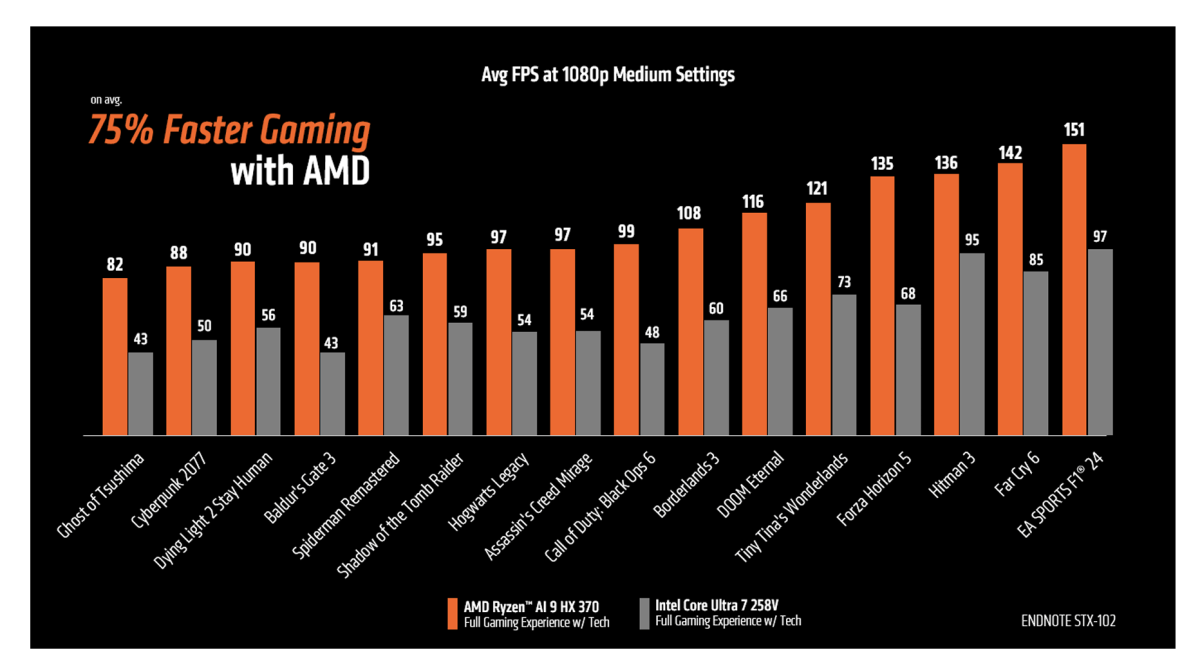
Image: AMD
AMD may already have won this generation of desktop processors. But the company is convinced that you should also be turning to Ryzen processors for mobile gaming, as a series of AMD’s own benchmarks show the Ryzen AI 300 absolutely dominating.
AMD’s Ryzen 7 9800X3D is the clear-cut winner in terms of desktop gaming. But a new blog post from AMD lays out how well the company believes it compares against Intel’s new Core Ultra 200 — the “Lunar Lake” processor — in terms of mobile gaming. AMD also didn’t hesitate to point out that its own HYPR-RX and FSR technologies give it a leg up over Intel’s XeSS, which only appears in a few games.
To be fair, Intel’s Lunar Lake is in the crosshairs of both the power-sipping Qualcomm Snapdragon X Elite — which it attempted to emulate by reducing power and performance — and AMD’s own Ryzen AI 9 HX 370. AMD’s gaming positioning basically echoed our own Ryzen AI 300 conclusions: Lunar Lake and the Snapdragon go head-to-head in terms of power draw and performance. AMD’s Ryzen, on the other hand, is embracing what it should: as a mobile hot rod.
AMD presented several benchmarks that obviously cast it in the best light. Still, some of the comparisons are pretty damning: In Forza Horizon 5, for example, AMD said it can achieve 135 frames per second at 1080p resolution, at Medium settings. That’s double the 68 fps that the Core Ultra 7 285V can achieve, the company said. (Head-to-head, the actual comparison was dead even; the additional frames came from AMD’s HYPR-RX technology.) AMD launched what it called Hyper-RX in 2023, turning on a number of frame enhancement technologies all in one go. AMD’s point is that HYPR-RX is available in “thousands” of games, while Intel’s comparable XeSS, well, isn’t.

AMD
However, AMD also came armed with benchmarks that show that the Ryzen AI 9 HX 370 simply whomps Lunar Lake in straight head-to-head comparisons, too. In the new Call of Duty: Black Ops 6, AMD says a laptop equipped with its Ryzen AI 9 HX 370 can hit 99 fps at 1080p Medium settings, versus a subpar 48 fps for the Core Ultra 7 258V.
All of the tests were performed without a dedicated, discrete GPU providing assistance, on similar Asus ZenBook laptops. AMD did have a slight advantage, potentially, as its configuration was inside a 16-inch ZenBook. Intel’s chip was inside a 14-inch version.
In total, AMD is claiming an average of 75 percent faster performance with its chip compared to Lunar Lake. It’s an interesting claim, as a study by Tom’s Hardware comes to the opposite conclusion: that Intel’s integrated GPU, part of the processor itself, is actually faster.

AMD
The subtext to all of this? As we head into the holiday season, AMD would obviously like to steal some of Intel’s market share in the mobile space, even as its desktop chips showed strong year-over-year growth.
But we also know that Intel plans to launch the Arrow Lake-HX and Arrow Lake-H chips for gaming laptops early in 2025, and most likely at CES. AMD obviously hopes to take the wind out of Intel’s, er, sales before the chips even leave port.
Author: Mark Hachman, Senior Editor, PCWorld

Mark has written for PCWorld for the last decade, with 30 years of experience covering technology. He has authored over 3,500 articles for PCWorld alone, covering PC microprocessors, peripherals, and Microsoft Windows, among other topics. Mark has written for publications including PC Magazine, Byte, eWEEK, Popular Science and Electronic Buyers’ News, where he shared a Jesse H. Neal Award for breaking news. He recently handed over a collection of several dozen Thunderbolt docks and USB-C hubs because his office simply has no more room.




